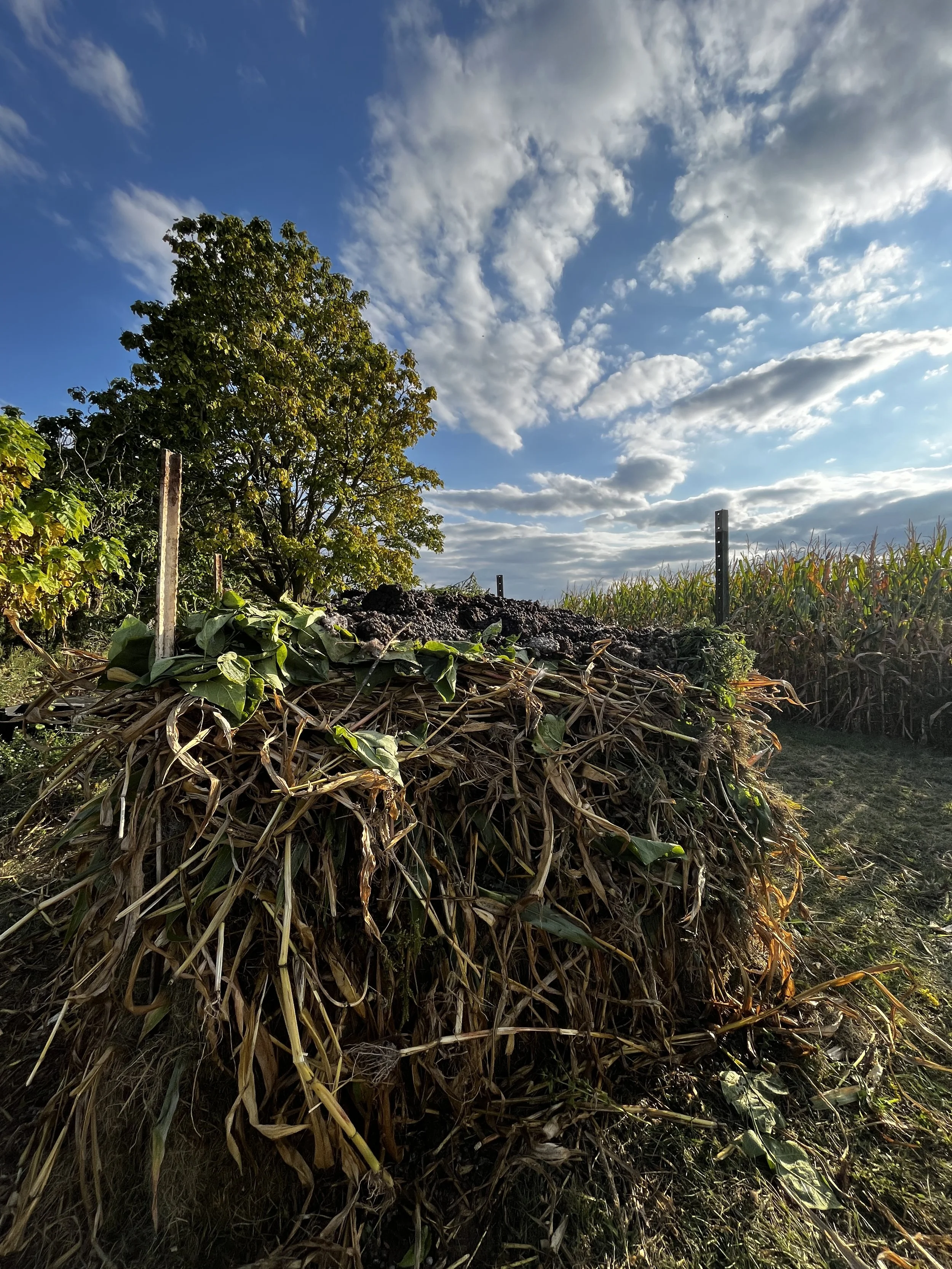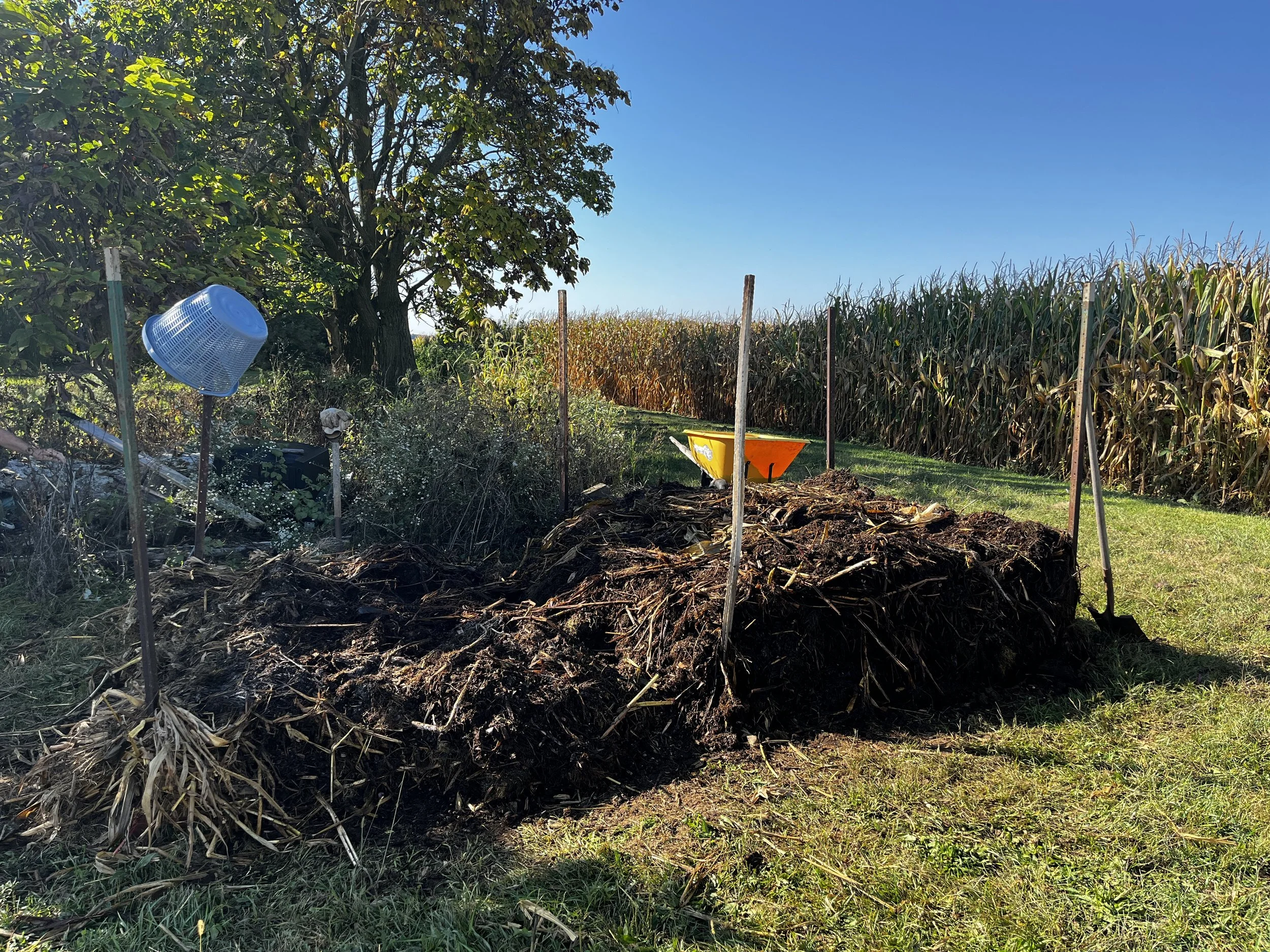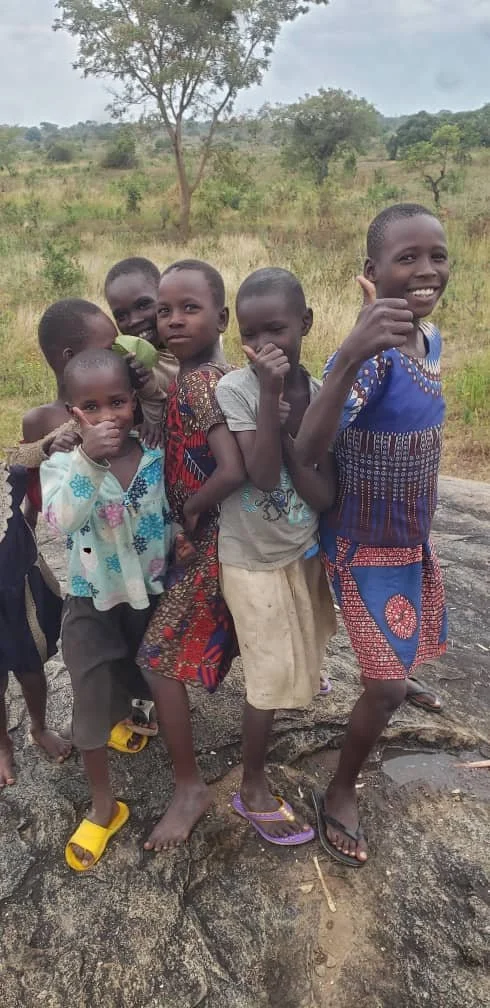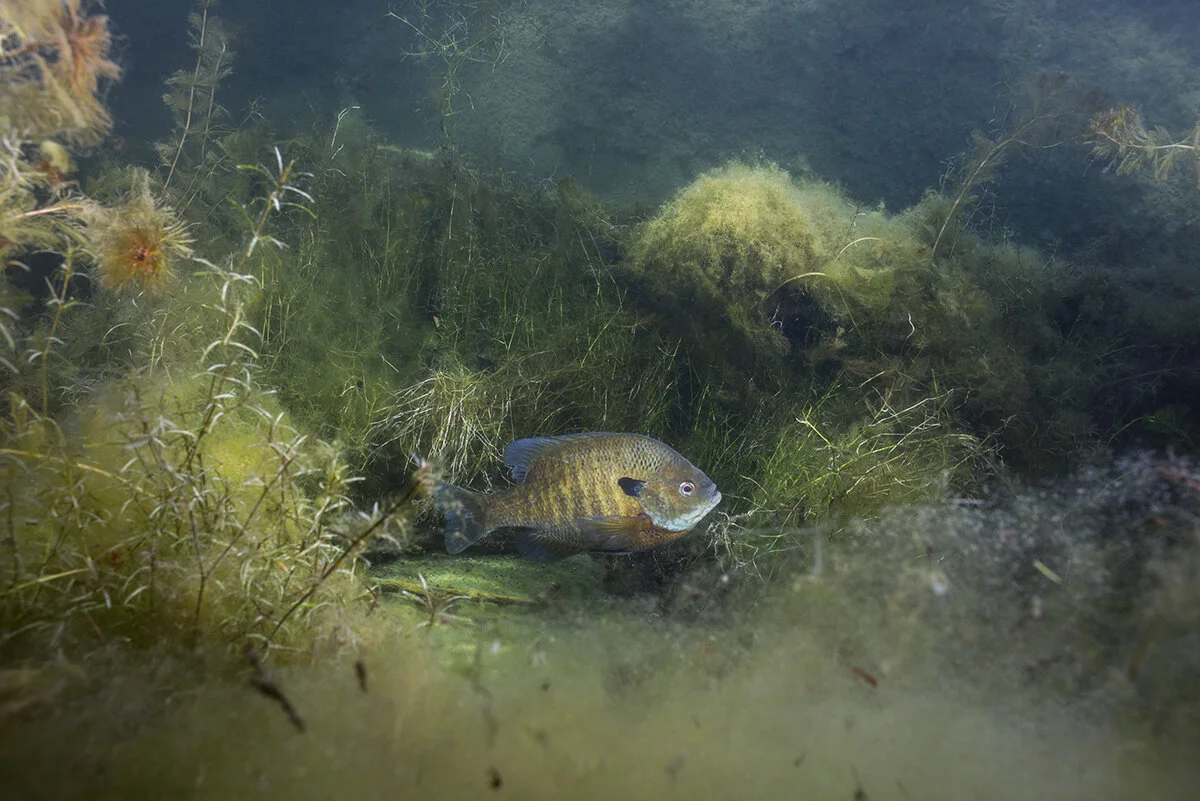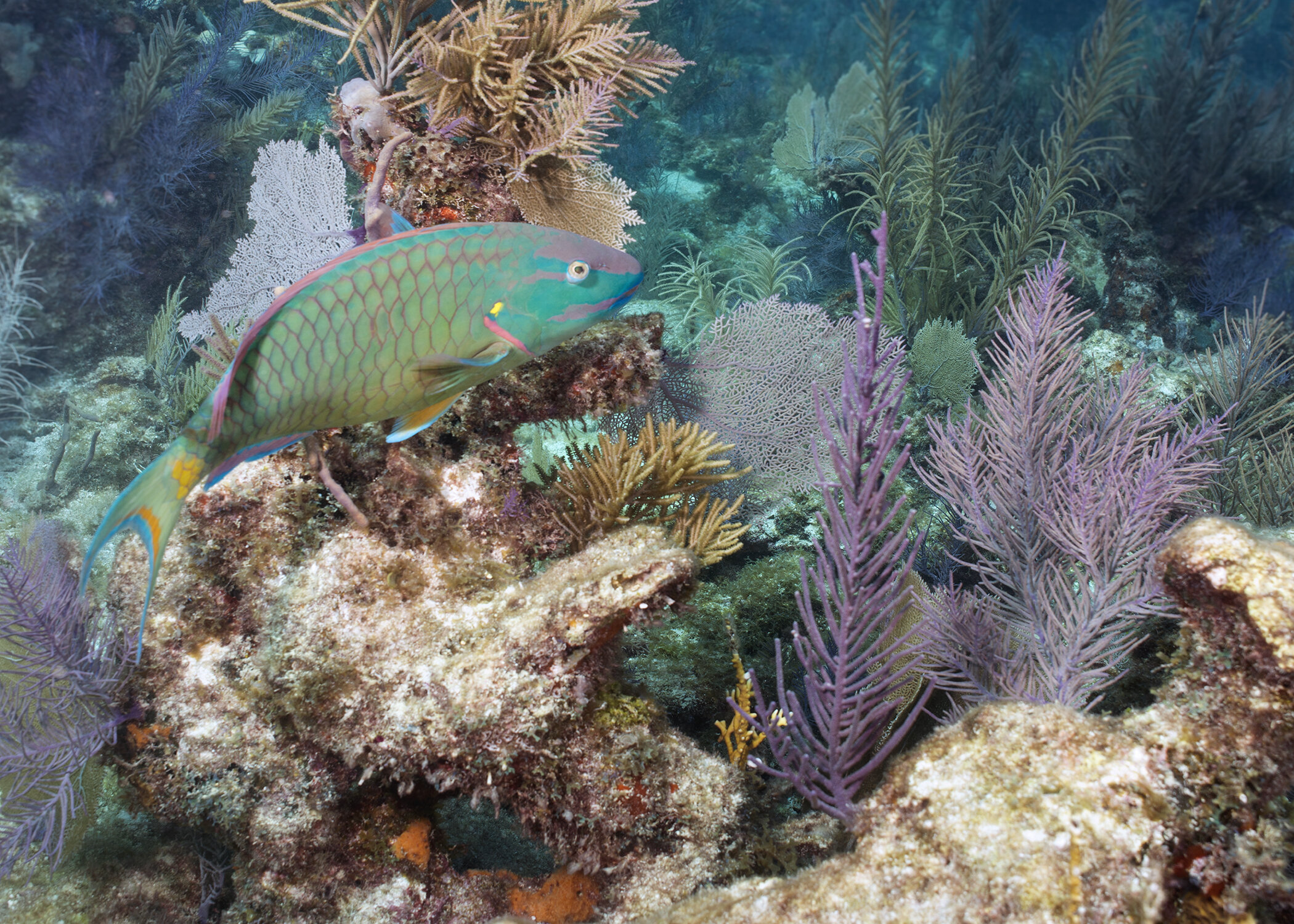Farming God’s Way, Clinton County
Composting
October 9, 2023
As the Fall season comes upon us it’s time to begin building the compost pile for next years inputs. We are building a 2x2x2m pile using 10cm of woody material the woody material really helps to encourage the fungal growth in the pile because it breaks down very slowly and keeps the pile aerated, 10cm of dry material the dry material adds bulk and carbon to the compost and should also make up 22.5% of the compost volume, 20cm of green material green leaves are a great source of sugars, which are necessary for good quality compost. The green component should make up 45% of your pile and should be used within 3-4 days, otherwise the sugars will convert into starch. Nitrogen is the essential fuel of the compost pile and gets the bacteria going. The most readily available Nitrogen component is manure and should make up 10% of the pile witch is your manure, 15 gallons of water per level. As we build the pile it begins to settle in you will make between 9-11 levels before you reach you 2m height.
Farming God’s Way, Clinton County
September 21, 2023
Poppin
Update!!!! This week begins the harvesting of our popcorn plots.
Covenant Church, West Lafayette Indiana
June 26, 2023
Today was the first day of Science Camp VBS.Today at camp, children explored gods amazing creation through the lens of physics. Daniel Lusk presented an encouraging presentation of “The Science of Magic. Then children completed hands-on activities, facilitated by Cook, Biotech volunteers. The younger kids explored properties of solutions through pH coloring, while the older kids explored concepts of density by making their own lava lamps. Campers had a snack and a free play to get to know their groups and leaders. The day concluded with a Bible lesson how our Lord created all things on Heaven and Earth from Acts 17:24. Ending our time with part one of our pirate themed skit.
Philips Quarry
May 13, 2023
Beneath the shimmering surface of Philips Quarry lies a captivating ecosystem teeming with life. Among the fascinating inhabitants are the bluegill and bass, two species that dominate freshwater environments with their distinct characteristics. Join us as we dive into these underwater worlds, exploring the unique features and behaviors that make bluegill and bass truly mesmerizing.
Over the previous weekend, Sheli Plummer and Carol Reed, two of our esteemed SEI instructors, successfully certified four open water divers. The visibility is approximately 15 feet with a slight haziness. Bluegill fish have begun their ascent towards the water's surface in preparation for the forthcoming spawning season. Diving at Philips Quarry, one can witness the bluegill engaging in spawning activities, typically found at depths ranging from 6 to 10 feet. Notable locations for observing this include below the dock and beneath the pontoon, among others.
Philips Quarry
Last year, I had the privilege of exploring the quarries of Indiana while testing the video capabilities of the Nikon Z7. Although the Z7 may not be the number one mirrorless camera available, its video quality is exceptional for both online media usage and commercial purposes. I was pleasantly surprised by the remarkable clarity of the footage captured. My original underwater rig, consisting of a Nikon D800, Ikelite housing, 161 strobes, 8 inch dome.
As an underwater photographer, I highly recommend aspiring photographers to invest in quality lenses, as they have the potential to serve you throughout your entire career. Unlike camera bodies that undergo yearly changes, you do not necessarily need the latest and most expensive camera on the market. For instance the Olympus TG-6 camera, which has garnered numerous underwater awards. With a price tag of just $400, this camera offers a wealth of features both above and below the surface.
If you have any inquiries regarding photography or scuba diving, feel free to reach out to me via email at Callowayproductions@gmail.com. I'll be more than happy to assist you.
Philips Outdoor Center
Nestled in the small town of Muncie, Indiana, Phillips Outdoor Center is a natural wonder that is attracting the attention of scuba divers from across the United States. This freshwater quarry is home to clearer waters in early spring and late summer. Protected marine life, and a rich history, making it the perfect destination for diving enthusiasts looking for unique freshwater diving locations. One of the most popular attractions of this outdoor center is its plethora of marine life you will become connected with are bluegills, bass, and turtles, making it an ideal spot for scuba diving and underwater photography. Philips Outdoor Center is known having served as a limestone quarry from 1890 up to 1917. Beginning in 1922 until 1954 it was operated by the Philipps family as a swimming area. Several wooden cages floated on barrels provided pools of various depths into a scuba diving destination in 1998.
The experience of diving in this quarry is like no other, as divers can navigate through structures across a serene underwater landscape up to 60 feet deep if you lay horizontally on the quarry floor. The quarry’s clear and calm waters also make it an excellent training ground for both new and experienced divers. Phillips Outdoor Center is committed to promoting environmental education and responsible diving practices for all levels. The center partners with local community groups to offer training in biology and geology, providing students with hands-on learning experiences that inspire a deeper appreciation for nature. Scuba diving at Phillips Outdoor Center will leave you wanting to dive it again as it offering something for everyone. Whether you are a certified diver dry- suit diver or just starting, this freshwater quarry opens a unique opportunity to explore the wonders of the underwater world. We at Leaird's Underwater Service caters to all skill levels, our friendly staff is always willing to assist divers to ensure you have a safe and enjoyable time.
Abola, Uganda
The world we live in is broken due to the sin of man, Genesis 3:17-19. But there is hope in our Lord and savior Jesus Christ. My African brother Moses lives in Kaberamido, a remote village in northern Uganda. Moses and I have weekly phone calls discussing life situations, ministry opportunities , and everyday life. Unfortunately due to the remote location in Uganda, Mo must climb this rock to gain a higher elevation in order to have better cell service. Moses informed me the other day “ man when I come to the rock the kids from the surrounding villages flock to me”. I said, brother this is amazing look how a phone call is allowing ministry to grow his people.
Mo is furthering the gospel message each time he returns to the corner stone of life, what a blessing it is to hear. God Is Good, and That’s His Nature WOOOOOW!!!
Papaya
Liberia International Christian College
The Master Gardener Program is organized by Maryland counties and Baltimore City, so if you are interested in becoming a Master Gardener or requesting volunteer support, please contact your local Master Gardener Program. Today, Hawaii, the Philippines, India, Ceylon, Australia, and tropical regions in Africa are the most fruitful papaya-producing regions. Smaller papaya-farming operations still exist in Central and South America.
Solar Dryer
Liberia International Christian College
The University of Maryland Extension Master Gardener Program is designed to train volunteer horticultural educators to support the University of Maryland Extension mission by educating residents about safe, effective and sustainable horticultural practices that build healthy gardens, landscapes, and communities.
Greenhouse Gardening
Liberia International Christian College
Farming Gods Way
Boapea, Liberia
Farming Gods Way
Collard Greens
We believe that Farming God's Way is part of God's solution for Africa, where it can be turned around from being the "begging bowl" to the "breadbasket of the world".
Farming God's Way is simply a tool of equipping to empower the poor to help themselves. Farming God's Way was originated before man was on the face of the earth, when God first put His ways in place to govern His creation and their interrelations with one another. God is the master farmer who has been farming this way since the beginning and by simply following His Ways, amazing solutions to the food security and poverty crisis can be revealed.
Proverbs 3:5-6, “Trust in the Lord with all your heart and do not lean on your own understanding. In all your ways acknowledge Him, and He will make your paths straight.”
Spiny Lobsters
When you think of lobsters, you probably think of a long crustacean with large claws, antennae, and fanned, muscular tails, you may also think of dinner. However, there are lobsters of all shapes, sizes, and looks that call the ocean home. One unique species is the Caribbean spiny lobster, also known as crawfish. Which are found in the Caribbean Sea, Gulf of Mexico, and the Atlantic Ocean, including Florida Keys
Spiny lobsters live in tropical and subtropical reefs, which are full of hiding spots for these nocturnal animals, seagrass meadows and algal beds, and in rocky, nearshore areas. As an added bonus, spiny lobster coloration and texture helps them blend into the reef, making it less likely that predators or prey will be able to see them clearly.
Duane Shipwreck
USCG Cutter Duane shipwreck is 327 foot long this wreck was intentionally sunk as an artificial reef on November 26, 1987. The wreck sits in 125 feet of water with a top depth of 60 feet at the Crow’s Nest. The majority of your dive will be done at 105 feet deep touring the main deck. As this wreck sits extremely close to the Gulf Stream, it is prone to currents that can make it un-diveable. If you do get to dive it, you will fall in love with all the massive coral growth and schools of fish that now call it home. Some fish to expect to see, Great barracuda, Atlantic spadefish, yellow tail snapper, goliath grouper, nurse shark, reef shark, and even bull shark call this wreck their home.
The Bluegill are Spawning!!!
The top 6ft water temp 60 and crystal clear, thermocline around 11-14ft. Come and swim with fish and enjoy the warming water.
Check out whats being built at Philips Quarry #philipsoutdoorcenter
Bluegill
The Bluegill are beginning to spawn at Philips Quarry these three can be found just off the south side of the doc at 8ft. Peak spawning season will be middle to late June in Indiana temps are rising each day. The health of the Bass, Bluegill, Paddle fish, Catfish, are growing well this year.
Come dive the quarry and swim with the new life about to take shape this coming month.
www.leaird-scuba.com/philips-outdoor-center
Growth in Philips Quarry
Wednesday March 22, 2020
Today was the first dive of the 2020 season boy was it a pleasant dive, viz from the surface to 12-15 ft was a good 20ft. Water temps ranged from (41 degrees @ 47ft, 50 degrees @ surface). The bluegill are looking very healthy this year looking forward to capturing more images and stories this spawning season. Vegetation is beginning to take shape soon we will see the bluegill forming those rock pile nests. Other fish spotted on today’s dive were Catfish, Bass, and Paddlefish. The American paddlefish is classified as endangered species in several states, but not at Philips Quarry you can swim with our family of five. Did you Know: That Paddlefish were once the most important commercial species in the Mississippi River Valley.
If you are interested in upcoming scuba classes
check the website for more information.
www.leaird-scuba.com
Bluegill
Bluegills begin nesting in the spring after the water temperature has reached about 65 °. Nests are built by the males in water from one to eight feet deep. Almost any type of bottom may be used for nesting but gravel is preferred.
Bluegill
Bluegills begin nesting in the spring after the water temperature has reached about 65 °.Nests are built by the males in water from one to eight feet deep. Almost any type of bottom may be used for nesting but gravel is preferred. The male uses his tail to form a shallow depression in the bottom, often known as a bluegill bed usually bed in colonies with many nests adjacent to each other in a small area. A female is admitted into the nest once she is ready to lay eggs. they are deposited onto the floor of the nest. The eggs hatch in three to four days depending on water temperature. June is peak season for spawning in Indiana Bluegill are often found in lakes and slow-moving streams. They prefer weed beds for cover. allows them to hide from predators and find aquatic insects to eat.
Fan Coral
Gorgonia ventalina is a salt water invertebrate that can be distinguished by its purple tissue and fan shape. The Common Sea Fan can be found in patches of reefs and outer areas of the reefs typically in water depths up to 30 meters, thriving in areas where the water flow is at a constant speed. The speed of the water is important due to the fact that all sea fans are filter feeders. Filter feeders are animals that depend on the flow of water to bring important organic materials and nutrients to the animal for the use of growth and respiration.
Scarus Parrotfish
Scarus rivulatus inhabit coral reefs and are most abundant in the mid shelf region inhabiting inshore reefs. Unlike other scarid species they often move onto the reef flat at high tide to feed and therefore may be seen in tidal pools.
Many coral reef fishes change their distribution and diet according to the availability of food resources. For instance parrotfish behavior seems to change in response to food resource availability. Meaning local variation in algal abundance can influence fish feeding preferences and modify parrotfish patterns of abundance . Parrotfishes are believed to be important contributors to healthy reefs because they consume algae that compete with corals for space in tropical waters
French Angelfish
French angelfish have thin bodies with protruding lower jaws and comb like teeth. This species is covered in black scales with a bright yellow rim with their eyes having yellow at the outer portion of the iris. Juveniles have a dark brown or black body with vertical yellow bands. French angelfish are found in coral reefs, rocky bottoms, grassy flats, and other places that provide coverage in tropical coastal waters. They have been found in the Atlantic Ocean off the coasts of Florida down to Brazil.
Adult angelfish’s diet mostly consists of sponges and algae. Many sponges have a V shaped pattern due to French angelfish bites off the coral. They also eat cnidarians including zoantharians and gorgonians as well as other aquatic invertebrate animals such as bryozoans and tunicates. Young angelfish eat algae, detritus, and ectoparasites cleaned off other fish.
Elkhorn Coral
This large branching coral often dominates reef communities: not only does it grow very fast at a rate of 5 to 10 cm a year. Elkhorn is very competitive and extends over other coral colonies. Elkhorn Coral is named after its large, thick branches that resemble elk antlers these branches are an important habitat for many reef species.
Colonies of Elkhorn Coral grow through a process known as fragmentation when a branch breaks off it will attache itself to the substrate and forms a new colony. Individual colonies also reproduce sexually once a year during which they release millions of gametes into the water column (known as spawning).
Southern Stingray
Stingrays are known for their stingers but they are actually very docile creatures. When not feeding southern stingrays bury themselves in the sand with only their eyes and spiracles visible. They can be found individually in pairs or in loose groups. Southern stingrays have flat diamond shaped bodies with indistinct heads. They are gray to dark brown in color, with pale bellies. Male southern rays are 2-3 feet across.
Rays feed on shellfish, worms, shrimp, crabs and small fish along the sandy ocean bottom. To locate their food, they use electroreceptors on their snouts as well as their excellent senses of smell and touch. Then they uncover prey by blowing water out through their mouth and flapping their "wings" over the sand.
Coral Reefs
Coral reefs are large underwater structures composed of the skeletons of colonial marine invertebrates called coral. The coral species that build reefs are known as hermatypic, or "hard" corals because they extract calcium carbonate from seawater to create a hard, durable exoskeleton that protects their soft, sac-like bodies. Other species of corals that are not involved in reef building are known as “soft” corals. These types of corals are flexible organisms often resembling plants and trees and include species such as sea fans and sea whips, according to the Coral Reef Alliance (CORAL).
Coral reefs cover less than 1 percent of the ocean floor all the reefs combined would equal an area of about 110,000 square miles (285,000 square km), only about the size of the state of Nevada. Nonetheless, they are among the most productive and diverse ecosystems on Earth.
About 25 percent of all known marine species rely on coral reefs for food, shelter and breeding. Sometimes referred to as "the rainforests of the sea" for their biodiversity coral reefs are the primary habitat for more than 4,000 species of fish, 700 species of coral and thousands of other plants and animals.
Atlantic Porkfish
Porkfish occur in the western Atlantic Ocean from Florida south to Brazil, inhabiting shallow reefs and rocky bottoms. The porkfish is found at depths of 6-65 feet. It is nocturnal often traveling in large schools, occasionally swimming with white grunts. Porkfish make a grunting sound, common to all grunts by rubbing their teeth together.
What do Porkfish eat they consume?
Invertebrates such as mollusks, echinoderms, crustaceans, and worms. Juvenile porkfish pick parasites from the skin and scales of other species of fish, and are considered “cleaners”.








